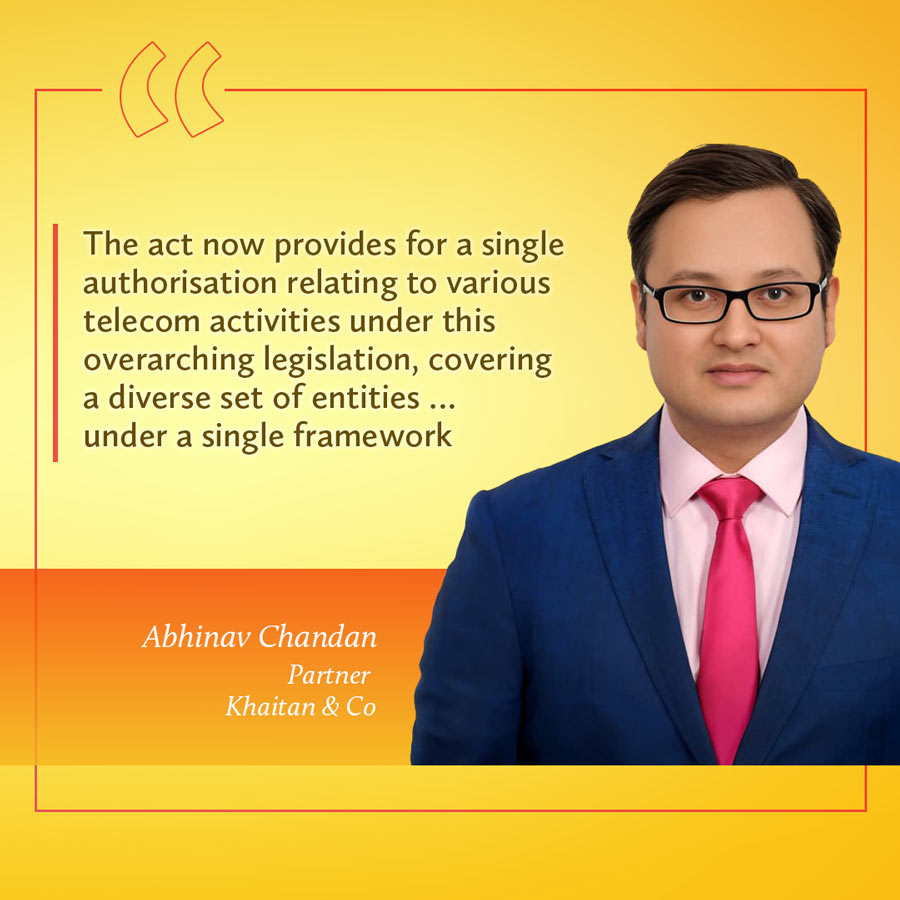India is bringing its outdated telecoms regime into the present with new legislation. But the reforms have sparked concern over privacy and implementation, writes Indrajit Basu
India’s Telecommunications Act, 2023, announced in December last year, is set to usher in radical reforms for India’s archaic telecoms regime. Yet while the act is aimed at streamlining telecom activities and introducing flexibility in regulating the rapidly evolving technology landscape, it faces criticism for potentially compromising fair privacy and surveillance practices, as well as for perceived regulatory overreach.
Critics have labelled the new legislation as regressive, and some experts believe India has missed an opportunity to implement meaningful reforms. “The act appears to be old wine in a new bottle and India seems to have wasted an opportunity to bring about real reforms in the telecom space,” says Salman Waris, New Delhi-based partner at TechLegis and head of the firm’s telecoms, media and technology (TMT) and intellectual property practice groups. “So, right now the regulatory landscape in the country remains a paradox as far as telecom services are concerned.”
From an interpretation and implementation perspective, the act “could be a nightmare”, he adds, since it lacks “specificity and detailing of the broad and ambiguous provisions introduced, whether they relate to new government powers on interception and internet shutdowns, or the lack of procedural safeguards or framework to prevent misuse of the provisions”.
The Telecommunications Bill, 2023, received presidential assent on 24 December 2023, granting the government the authority to temporarily take control of telecoms services in the “interest of national security”.
Although the act has been published in the official gazette – which means that it has been granted legal weight – it has not been enacted yet, and key rules under the act are yet to be notified.
When the act becomes law, it will mainly replace and repeal India’s existing telecoms regulatory structure, which includes the Indian Telegraph Act of 1885, and the Indian Wireless Telegraphy Act of 1933.
The new act is the first major reform – a much-needed regulation in the telecoms sector to bridge the gap between existing laws and new communication technologies. India’s current laws are outdated and do not adequately address the governance requirements for technological advancements seen in recent decades.
The presidential assent indicates that the authorities want to support the expansion of the communications sector while establishing a telecoms regime in line with international norms.
New Delhi-based Rishi Anand, a partner at DSK Legal, says: “The act envisages governing telecommunications services and networks, telecommunications equipment and infrastructure, and spectrum at a broader level when compared with prevailing laws, and sets out provisions in relation to exclusive privilege of government; regulation of modern technology; simplified procedure with respect to merger, demerger and acquisition; enablement of the regulatory sandbox; and spectrum assignment.”
The act allows for a single authorisation for diverse telecoms operations under one overarching statute. This framework includes a wide spectrum of businesses, from core telecoms carriers to passive telecoms infrastructure suppliers, all operating inside a single framework.
Privacy concerns
Amid this paradigm shift, the act faces scrutiny and criticism, with various stakeholders expressing concerns about its implications.
“The principal concerns surrounding the act pertain to the endowment of vast powers to the central and state governments in matters of public emergency, or for public safety,” says Anand, of DSK Legal.
“The government can take temporary possession of a telecommunications service or network, suspend telecommunications services, and intercept messages from any telecommunications equipment, which may include messages sent from cellphone, laptop, server, etc.”
Human rights activists say such powers are worrisome, even though they are meant to improve national security, because they give the government the power to invade people’s privacy.
Namrata Maheshwari, a policy counsel at the digital civil rights organisation, Access Now, said in a recent statement: “The bill is regressive as it enhances the government’s colonial-era powers to intercept communications and shut down the internet. It undermines end-to-end encryption, which is crucial for privacy.”
The act’s provisions for data retention and sharing also raise questions about the protection of sensitive personal information. “In a digital age when privacy is increasingly under threat, the act must strike a balance between national security interests and individual privacy rights,” says Anand.
However, according to Abhinav Chandan, a New Delhi-based partner in the TMT practice group of Khaitan & Co, the act also limits and structures certain government powers.
One important addition, he says, is the right of way regime curtailing arbitrary powers of local authorities, like sealing or shutting down telecoms networks at particular locations without the permission of the central government, except in the case of natural disasters or public emergencies.
The act creates a new dispute resolution mechanism that empowers the central government to develop or authorise online dispute resolution methods for the rapid settlement of disputes in the first instance.
The government can also appoint adjudicating officers (AOs) to conduct investigations and make orders in the event of licensing or permission breaches, or act violations. These inquiries can be initiated either in response to complaints, or by AOs acting on their own initiative.
An appeal of an AO’s order should be filed with the designated appeals committee (DAC), which will be chosen by the central government. The DAC’s rulings can be appealed to the Telecom Disputes Settlement and Appellate Tribunal for violations of authorisation or assignment, and to a civil court for other reasons as stipulated by the act.
Separately, for violations of the act’s conditions, the government’s authority to impose fines, including through the AOs and DACs, has been strengthened and made more consistent with contemporary standards, depending on the nature of the offence.
Market dynamics
Yet another contentious issue is the allocation of spectrum. The act views spectrum as a commodity controlled by the government for the benefit of the people. It can be shared, traded, sold or relinquished, but only in accordance with the rules outlined by the act. Hence, anyone wishing to use the spectrum must first obtain an allocation from the government. The allocation, too, must adhere to the provisions of the act, which outlines a mixed approach to spectrum, with auctions as the primary method but allowing administrative allocation in specific cases as an exception. This, says Waris, “could unintentionally create an uneven playing field for new entrants”.
The allowance for allocation outside auctions bypasses the competitive bidding process, potentially giving established players with political clout an edge in securing valuable spectrum, he says.
The design of the auctions can also be an impediment. The act lays down complex bidding procedures and high upfront costs, which could discourage smaller companies from participating and leave established players that have the financial resources to dominate the auctions.
That gives rise to the big risk of a significant portion of the spectrum going to the existing players, after the bids. “There may not be as much left after that for new companies to enter the market,” says Waris. “This, too, limits their ability to compete effectively,” he says, since spectrum allocation is critical for telecoms operators when entering and expanding into new markets. Having enough spectrum is essential for offering high-quality services, attracting consumers and competing successfully. But Waris says that the mixed approach has an upside as well. “Administrative allocation can be used to prioritise spectrum allocation for public services like defence, disaster management or state-owned telecoms companies. This can ensure these services have reliable access to the spectrum,” he says.
Impact on OTT players
An official clarification by the information technology minister on 22 December 2023 stated that the act does not regulate the over-the-top (OTT) players, for which regulation will continue under the Ministry of Electronics and Information Technology.
But experts say that, despite this exclusion, specific OTT technological capabilities and activities related to expanding telecoms networks may still be subject to regulatory scrutiny and exposure.
The act’s definition of the word “message”, in particular, could become thorny by inadvertently subjecting OTT players to regulatory requirements meant for traditional telecoms services, leading to uncertainty and potential legal challenges.
“The definition of the term ‘message’ under the act is very broad and can be construed to include services such as those of OTT platforms,” says Anand. “The lack of a clarification in this regard leaves the interpretation of the act open in terms of its applicability on OTT services. Given this, should OTT services continue to be governed by the act, the relevant service providers would have to procure authorisation from the central government to provide such services.”
Notable reforms
To align with the recently enacted Digital Personal Data Protection Act, 2023, the act allows licensees and authorised entities to submit voluntary undertakings disclosing their non-compliance, and the mitigation measures they have taken or intend to take to rectify such non-compliance.
These undertakings can now serve as a defence against unfavourable proceedings (if provided before the commencement of procedures), or as mitigating factors in assessing relevant civil fines, etc., says Chandan, of Khaitan & Co. “This promotes ease of compliance for stakeholders.”
The act also establishes regulatory sandboxes to encourage technological growth and advancement, facilitating live testing of innovative goods, services, processes and business models. Rules governing the manner and duration of such sandboxes will be issued in due course.
The act empowers the government to designate any telecoms facility as “vital telecommunications infrastructure” if its interruption poses a threat to national security, public safety, health or the economy.
It also specifies that the government may issue rules to further define and regulate the scope of such crucial telecoms infrastructure. “This is in line with the government’s classification of telecoms services as essential services under the Disaster Management Act, 2005, through which the government has recently provided various exemptions to this sector during the pandemic era,” says Chandan.
One country, one act
According to experts, in the current digital era, robust telecoms infrastructure and services have conspicuously become the backbone of global economies and trade. Telecoms connectivity and accessibility have also been at the forefront of India’s growth path, an essential part of the Digital India mission, a government campaign to digitally empower citizens, and one of the most critical socioeconomic enablers for India’s ever-increasing subscriber base – the second-largest in the world.
The need for scaling up telecoms infrastructure was also starkly highlighted during the covid lockdowns worldwide. However, before the Telecommunications Act, 2023, India’s telecoms regulatory framework had remained fragmented under several laws, licences and authorisations that were archaic.
The technology and telecoms landscape worldwide, meanwhile, kept undergoing significant transformations, ultimately forcing India’s framework to be modernised and consolidated.
Leading countries like the US, the UK and Australia have already updated their regulatory frameworks to align with emerging trends and technologies, such as the internet of things and 5G.
Emerging technologies also imply newer service delivery models for consumers and a corresponding exponential increase in the appetite for digital consumption, requiring the rapid expansion of India’s telecoms infrastructure and services, which have become increasingly capital and labour-intensive.
With this outlook, the primary objectives of the act are modernisation and promotion of investments, while also ensuring business continuity without unwarranted policy disruptions due to the new law. Chandan says: “The act now provides for a single authorisation relating to various telecom activities under this overarching legislation, covering a diverse set of entities, from core telecom operators to passive telecom infrastructure providers, under a single framework.”





























